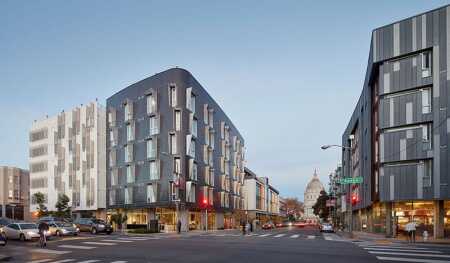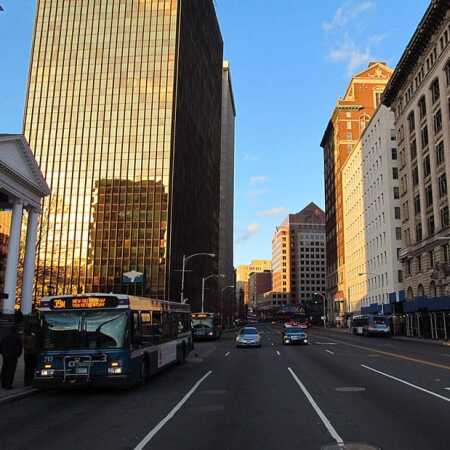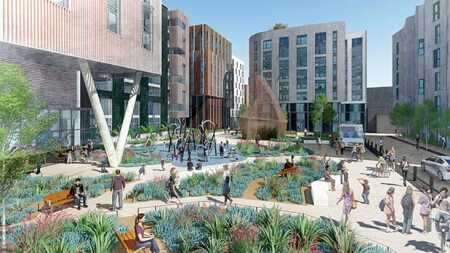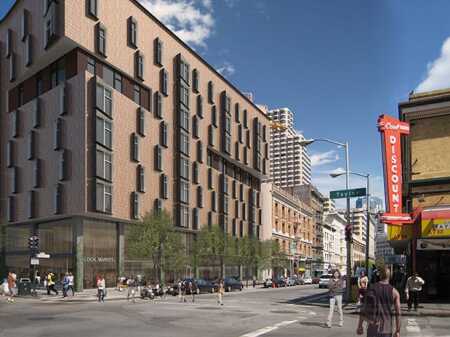This article appeared in the 2018 Spring issue of Urban Land on page 146.
The rising popularity of human-powered transportation, walking and bicycling, and widespread availability of ride-hailing services like Lyft and Uber plus car-sharing services like Zipcar and Getaround, and the introduction of same-day delivery services have all reduced the need for individuals to own—and park—cars.
At the same time, costs of construction are at historic highs in dense urban areas, creating a challenge for developers to meet housing demand. Individual unit sizes are shrinking in response, allowing greater density. However, with smaller units, the number of parking spaces goes up, too, if traditional parking ratios hold. High construction expenses result in a very high per-space cost for parking spaces, especially for structured parking, which can run $50,000 or more for a single space.
In response to these factors, municipalities are changing the way they handle parking. Cities around the United States are eliminating minimum parking requirements for new developments.
Last year, officials in Buffalo, New York, removed parking minimums citywide for commercial and residential projects of less than 5,000 square feet (465 sq m). Also last year, Hartford, Connecticut, scratched parking minimums across the city for commercial and residential developments, regardless of size. Many other municipalities have removed parking minimums for at least one part of the city or have lowered or removed minimums for certain uses. San Francisco has gone a step further, establishing parking maximums for downtown and nearby areas well served by public transit, capping the amount of parking that developers are allowed to build for multifamily housing.
Nevertheless, even multifamily housing developers who support creating walkable neighborhoods and prioritizing alternative forms of transit still think they need to follow traditional parking ratios or the units will not rent or sell. What follows are common concerns we have heard in our architecture practice, as well as the experiences and counterarguments we have come across that make us optimistic about reaching a future in which parking plays a much-diminished role in the urban environment.
1. Will planning commissions embrace attempts to reduce or eliminate parking?
About 20 years ago, a development proposal came before the San Francisco Planning Commission: a new restaurant with two residential units above and no parking spaces for the residents. Even though the project was small, dozens of neighbors showed up at the commission hearing to share their fears about the loss of street parking. The commission chairman responded by saying, “I moved from Manhattan to San Francisco so I could park.” The commission voted down the no-parking proposal. Back then, the primary concerns of neighbors of proposed projects were increased traffic and competition for street parking.
In the intervening years, as voter attitudes toward automobiles have changed, the San Francisco Planning Commission has reversed its approach.
In 2005, the commission established caps specifically addressing the amount of parking developers can build for multifamily housing downtown and nearby areas well served by public transit. The commission encourages projects with active uses on ground floors, and not requiring parking makes this easier by freeing space for commercial or residential use and obviating the need for a wide parking garage door on the street. Limiting driving also reduces infrastructural maintenance costs. Last year, San Francisco’s Transportation Demand Management Ordinance acknowledged that parking generates auto traffic (rather than the converse—that traffic is mainly caused by cars circling in the hunt for scarce parking, which is often the pro-parking argument).
2. What about irate neighbors?
Although some community groups still push developers to add parking, many neighborhood associations are now recognizing that car ownership is dropping. We recently designed a project in central San Francisco, the Brady Block, which will have about 600 new units of housing, a new office building, and new public realm and streetscape improvements on Market Street. The parking ratio is about 0.5 spaces per apartment. The local neighborhood group, the Hayes Valley Neighborhood Association, would have preferred that the ratio be 0:1, and, in fact, we were concerned members would come to the Planning Commission hearing to demand less than the 0.5 ratio. In the past, we would face local resident groups who would oppose projects for the opposite reason.
Urban advocacy groups have played a key role in changing public opinion. Locally, these include SPUR (San Francisco Bay Area Planning and Urban Research Association), Livable City, the San Francisco Bicycle Coalition, TransForm, and the San Francisco Housing Action Coalition, among others. They have been highly active in encouraging reliance on—and infrastructure support for—walking, bicycling, and transit, and they endorse developments that deemphasize reliance on the automobile.
3. Even if residents say they drive less, don’t they really want to own a car?
We have not found this to be the case.
An example is one of our recently completed projects, Potrero 1010, a 453-unit mixed-use, mixed-income development in San Francisco’s Potrero neighborhood. Developed by Chicago-based Equity Residential, Potrero 1010 has 0.65 parking spaces per unit, which was the city’s allowed parking maximum, and the parking spaces are not bundled with the units but available for rent separately.
About half of the parking spaces are rented, while the others remain empty, indicating that the development could have succeeded with half the parking. The building promotes walkability and alternative forms of transit: it has extensive bike storage with bike repair stands, and it is organized around a new city-owned one-acre (0.4 ha) park accessible to the public via a midblock passage lined with active uses.4. Renters may be willing to forgo cars, but what about condominium buyers?
We designed a no-parking condo building, 388 Fulton, in Hayes Valley, San Francisco, for local developer 7x7 Development, with 69 studio and two-bedroom market-rate units. Even with zero parking, the units sold out easily in 2016 and early 2017.
5. Don’t residents prefer the security of driving in their own cars?
At 388 Fulton, most of the 35 325-square-foot (30 sq m) micro-unit studios were purchased by single women in their 20s and 30s. This challenges the idea that car ownership is perceived as safer even though parking garages are high-crime areas. With the ubiquity of ride-hailing services, residents can walk out their front door, hop in a vehicle, and get dropped off at their destination rather than risk having to drive themselves, park several blocks from their destination, and walk the remaining distance, or walk through a parking garage getting to and from a car.
6. How can affordable-housing developers and operators help residents travel to jobs and schools without providing parking?
“While our priority is to provide housing, we do not want simply to pass the cost of parking on to our residents,” says Jerry Jai, senior project manager at East Bay Asian Local Development Corporation (EBALDC), an Oakland-based nonprofit provider of affordable housing. “If we don’t offer parking, does that limit job opportunities? What about costs due to towing, break-ins, and parking tickets?”
Jai notes that car ownership is not just about quality of life; it can also help parents transport their kids to school. “We don’t want to be in a patronizing position where we say to residents, ‘You should be able to get by without parking.’” However, Jai points to new sources of funding like California’s Affordable Housing and Sustainable Communities Program (AHSC) as a promising opportunity. “Sources like AHSC are exciting because they encourage affordable-housing developers to build in transit-rich areas and to increase transportation connections—bus, light rail, etc.”
Not paying to build parking can also free up money to provide other supportive resources to residents in need. In San Francisco’s Tenderloin neighborhood, Curran House, completed in 2005, has 67 affordable family apartments and no parking spaces. Most of the low-income residents cannot afford a car, and the central site has excellent public transit connections. Providing parking would have added several million dollars to the construction cost.
By not spending money—or dedicating space—for structured parking, the nonprofit housing developer, Tenderloin Neighborhood Development Corporation (TNDC), was able to provide additional units, a courtyard, space for supportive services, neighborhood-serving retail space, and office space for itself.
Our firm is working on another project with TNDC, 222 Taylor Street, just a block from Curran House on the site of a former parking lot. The design includes 113 affordable family apartments and no parking, reserving the ground level for a much-needed community grocery.
Now that Congress’s overhaul of the federal tax code has lowered the tax rate for corporations and federal affordable housing tax credit programs have less value to corporations, developers of affordable housing will be even more strapped for funds, and eliminating parking will become even more essential as a strategy for meeting housing demand.
7. Will lenders be willing to finance low- and no-parking developments?
Developers who plan to build multifamily housing and then sell it have to convince equity investors and loan committees to accept lower parking ratios. The investment community is often reluctant to embrace lower amounts of parking, fearing that renters and especially buyers will be turned off, particularly in places outside highly dense urban areas like San Francisco.
However, this is changing, says Will Goodman, vice president of San Francisco–based Strada Investment Group. “There is an evolution happening with the investment community to accept no parking or low parking,” he says. “We are seeing parking utilization rates go down in new buildings and technologies like ride share expanding. So, investors are increasingly buying into the story that most people don’t need parking day to day, especially if they are in an area that is near to transit and where traffic is bad. In these locations, people are typically not driving to work. They may want a car for weekend excursions, but it does not need to be on site.”
Particularly in super-hot markets like San Francisco, there are many precedents that investors can look at to understand that renters are willing to forgo on-site parking. But even in slightly cooler markets like downtown Oakland, Goodman says he is finding that investors are willing to take the risk.
Strada is about to break ground on a new luxury high-rise rental development in downtown Oakland, where there has not been a luxury high-rise completed since 2009. “All the comps are based on 2009 or pre-2009 parking-to-dwelling-unit ratios, which are 1:1,” Goodman says. “There were some members of the investment community who were not comfortable with not providing parking. We were ultimately able to find the right investors who saw the project as representing the future of Oakland development. They understood that this is a project in an extremely transit-rich part of the city. Additionally, there are a number of garages nearby so that our residents could have a secure parking space off site.”
The simplest solution is for municipalities to put parking maximums in place for transit-rich areas, as San Francisco has done. These maximums change the culture, providing successful examples of developments with limited parking, which consequently makes it much easier for developers to persuade investors to get behind low- and no-parking developments.
Even in more car-oriented markets, some developers are seeing an opening for reducing parking. In Minneapolis, we are working with local developer Lander Group on a mixed-use residential project on a 1.5-acre (0.6 ha) site in the Lyn Lake neighborhood. It is in the conceptual design phase, and the developer aims to balance density and parking requirements with a desire to create a vibrant streetscape and public realm.
“The larger projects with institutional investors are going to be very cautious about reducing parking ratios,” says Michael Lander, founder and president of Lander Group. “But lenders are starting to understand that in some of the denser, more transit-rich markets there is not as much need for parking. And they know the enormous cost of parking. So there is beginning to be a changing of the status quo.”
8. Millennials may be forgoing car ownership, but are baby boomers still attached to owning their own cars?
Even many baby boomers are beginning to question the need for cars and parking, Lander says. “The baby boomer generation in the Midwest is often still saying the same thing when it comes to proposed new developments: ‘not enough parking, too much traffic.’ It is a relearning process for baby boomers,” says Lander. “When empty-nesters move downtown, they often bring two cars. But once they try the alternatives, like ride share, many of them reconsider the practicality of owning more than one vehicle.”
9. Does this idea have traction beyond San Francisco?
Last year, San Francisco developer Panoramic Interests proposed building 1,031 market-rate apartments near the West Oakland station on the Bay Area Rapid Transit (BART) system and providing no parking for residents. The project is going through the approval process. Also in Oakland, EBALDC is looking for creative ways for projects to make economic sense despite rapid construction-cost escalation. One of these ways is reducing or eliminating parking. “The elimination of parking in one of our recent projects resulted in major savings, which made the difference between a feasible project versus one that was not,” says Jai.
Even outside coastal markets, possibilities exist to minimize parking. “Midwestern cities like Minneapolis are different from denser, more transit-rich cities,” Lander says. “There is more need for a car. So, I think there will still be a lot of auto mobility in the future, but many more alternatives to private ownership like Uber and car-sharing services. This will significantly reduce the need for parking.”
10. Is the preference for not owning a car just a short-term trend?
A future not dominated by privately owned cars may be a long way off, but increasingly the use of a car is becoming detached from the need for parking. In urban areas, driverless taxis are likely to hit the streets much sooner than anticipated. Waymo, Google’s self-driving car project, has teamed with Fiat Chrysler Automobiles to announce plans to start offering driverless ride-hailing service in Phoenix by the end of this year. General Motors plans to launch a fleet of driverless taxis in multiple cities in 2019. At the same time, municipalities that once focused on providing ample street parking are now prioritizing bus stops, loading zones, bicycle lanes, and ride-hailing stops.
The days when multifamily housing developers must provide individual parking spaces are numbered. “Who knows? Perhaps in 20 years, no one will be having this debate because of autonomous vehicles, ride sharing, and improvements in public transportation,” says Jai. “We need to remember that we are building housing that is supposed to last 50 years.”
David Baker is a principal and Brad Leibin is an associate at David Baker Architects in San Francisco.









